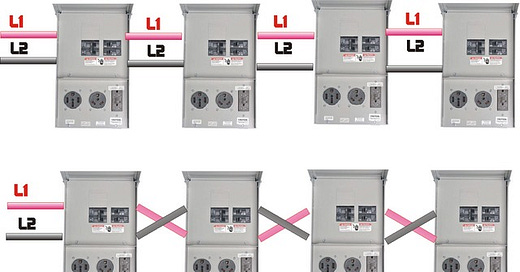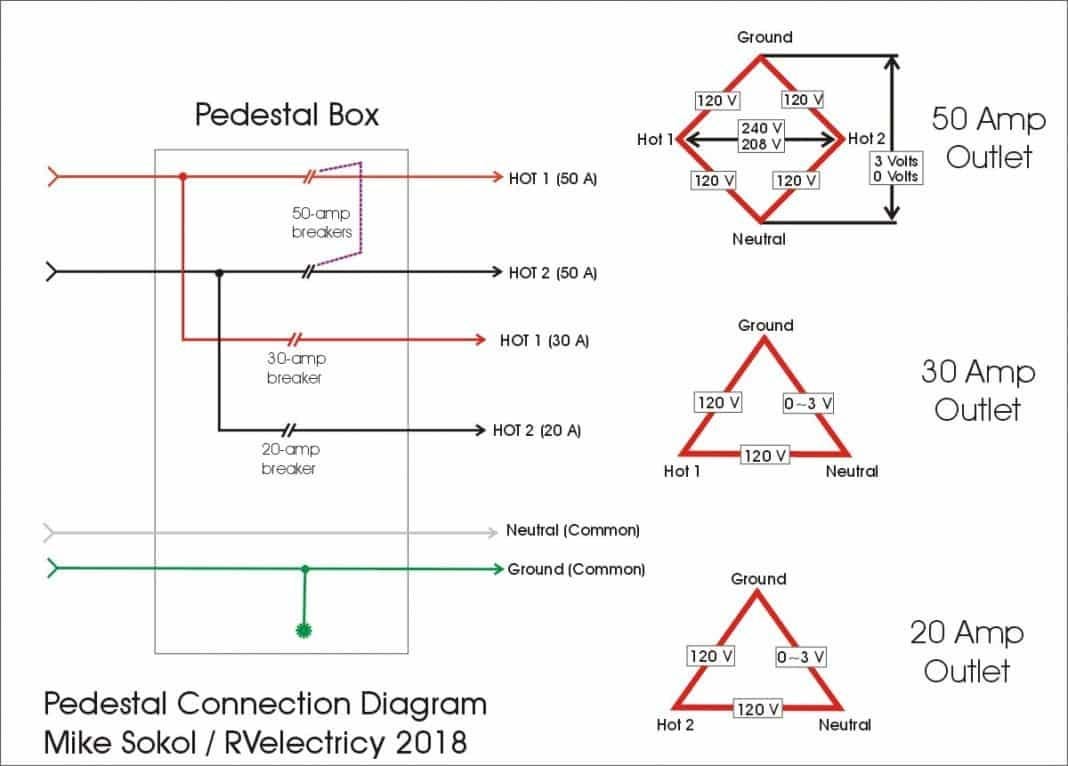I answer a question from the late Gary Bunzer
Unbalanced current in campground 50-amp pedestal loops can create unequal voltage sag under load...
Voltage Difference on Two Legs of a 50-amp Service
I received an email from Bob S. recently, regarding some strange AC voltage measurements at his RV resort. I've asked electrical guru, Mike Sokol, to weigh in on this one. Here's Bob's question, followed by Mike's insightful response.
- Gary Bunzer
My motorhome is hooked up to a 50-amp circuit in our RV Resort. Everything works great until the afternoon, when the temperature gets above 85-degrees. I have a built-in voltage protector with a digital readout. In the morning I get 118 volts on both sides (legs) of the circuit. In the afternoon it reads 118 volts on one side and 103 volts on the other. This causes my power to shutoff momentary during the afternoon. Sometimes more then once. To prevent damage I shut of the air conditioner. I use propane for refrigerator and hot water. What would cause the low voltage on one side of the 50-amp circuit? Bob S.
Hi Bob!
This is Mike Sokol, and here's what I suspect is happening. As you should already know, in a 240-volt split-phase service there are two hot legs with 120-volts each. Let's call them Hot-1 and Hot-2 for this discussion.
Now, your 50-amp/240-volt shore power is hooked up to both of these legs, and should be current balanced internally. That is, the manufacturer will have wired the RV appliances so that half of the AC loads are connected to Hot-1, and the other half of the loads are connected to Hot-2. It won’t be exactly balanced, but it will be pretty close.
Now as current is drawn through a wire, there will always be some sort of voltage drop. Most of the time it's only a few volts, but as a wire is extended throughout the campground, each additional site will cause a few more volts of drop and it can easily reach 10 or more volts total drop on the pedestal at the end of the loop.
If you've forgotten the basics of voltage drop, read my article HERE.
What’s happening?
Now, as mentioned before, your coach is probably pulling close to equal current on both the Hot-1 and Hot-2 wires, so when there's a voltage drop it should be pretty much be equal between the two legs. However, not every trailer in the campground will have 50-amp shore power. RVs with 30-amp/120-volt shore power are also very common. Since these 30-amp RVs are only drawing current from one of the hot legs supplied throughout the campground, that's the only leg that will have a voltage drop.
In a properly wired campground system, the electricians will alternate the 30-amp service connection. So the first pedestal should have its 30-amp circuit connected to Hot-1, and the second pedestal should have its 30-camp circuit connected to Hot-2, the third pedestal connected to Hot-1, and so on down the line... This is done by reversing the hot-1 and hot-2 leges feeding the 50/30/20-amp pedestals. See the lower wiring diagram below.
I'm guessing that at your particular campground, the electrician has wired every single pedestal in the same loop with the 30-amp outlets wired to the same hot leg. So when all the air conditioners get running at the same time, all those 30-amp hookups are drawing down one of the hot legs a lot more than it should, while the other hot leg is going along for the ride.
The solution is to have the electrician inspect each pedestal and swap the Hot-1 and Hot-2 legs on every other pedestal, which alternates the 30-amp circuit breaker connection so the load is equally shared between the two hot legs. This not only reduces the voltage drop in the neutral conductor, it also lowers the campground’s electric bill since there won’t be as much underground voltage drop and heating in the neutral conductor feeder. So there you go!
Let’s play safe out there… Mike










Love this article, I had mentioned this same concept to a campground adding new sites to make sure they alternate just as you said.
I’m testing a Fox & Hound that’s rated to trace energized conductors up to 250 volts. Should be perfect for sorting out pedestal hookups.